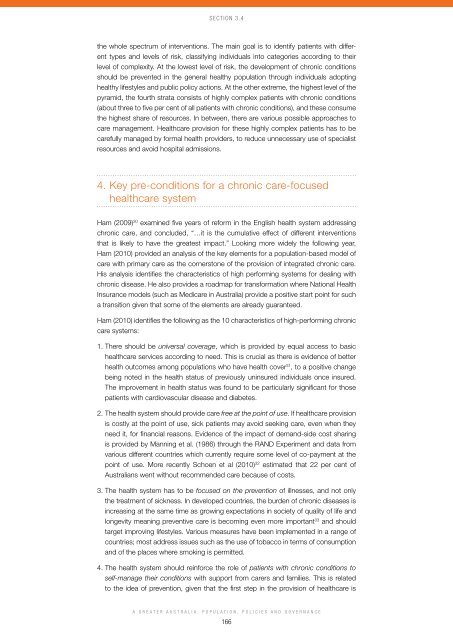A Greater Australia: Population, policies and governance - CEDA
A Greater Australia: Population, policies and governance - CEDA
A Greater Australia: Population, policies and governance - CEDA
- No tags were found...
Create successful ePaper yourself
Turn your PDF publications into a flip-book with our unique Google optimized e-Paper software.
Section 3.4the whole spectrum of interventions. The main goal is to identify patients with differenttypes <strong>and</strong> levels of risk, classifying individuals into categories according to theirlevel of complexity. At the lowest level of risk, the development of chronic conditionsshould be prevented in the general healthy population through individuals adoptinghealthy lifestyles <strong>and</strong> public policy actions. At the other extreme, the highest level of thepyramid, the fourth strata consists of highly complex patients with chronic conditions(about three to five per cent of all patients with chronic conditions), <strong>and</strong> these consumethe highest share of resources. In between, there are various possible approaches tocare management. Healthcare provision for these highly complex patients has to becarefully managed by formal health providers, to reduce unnecessary use of specialistresources <strong>and</strong> avoid hospital admissions.4. Key pre-conditions for a chronic care-focusedhealthcare systemHam (2009) 30 examined five years of reform in the English health system addressingchronic care, <strong>and</strong> concluded, “…it is the cumulative effect of different interventionsthat is likely to have the greatest impact.” Looking more widely the following year,Ham (2010) provided an analysis of the key elements for a population-based model ofcare with primary care as the cornerstone of the provision of integrated chronic care.His analysis identifies the characteristics of high performing systems for dealing withchronic disease. He also provides a roadmap for transformation where National HealthInsurance models (such as Medicare in <strong>Australia</strong>) provide a positive start point for sucha transition given that some of the elements are already guaranteed.Ham (2010) identifies the following as the 10 characteristics of high-performing chroniccare systems:1. There should be universal coverage, which is provided by equal access to basichealthcare services according to need. This is crucial as there is evidence of betterhealth outcomes among populations who have health cover 31 , to a positive changebeing noted in the health status of previously uninsured individuals once insured.The improvement in health status was found to be particularly significant for thosepatients with cardiovascular disease <strong>and</strong> diabetes.2. The health system should provide care free at the point of use. If healthcare provisionis costly at the point of use, sick patients may avoid seeking care, even when theyneed it, for financial reasons. Evidence of the impact of dem<strong>and</strong>-side cost sharingis provided by Manning et al. (1986) through the RAND Experiment <strong>and</strong> data fromvarious different countries which currently require some level of co-payment at thepoint of use. More recently Schoen et al (2010) 32 estimated that 22 per cent of<strong>Australia</strong>ns went without recommended care because of costs.3. The health system has to be focused on the prevention of illnesses, <strong>and</strong> not onlythe treatment of sickness. In developed countries, the burden of chronic diseases isincreasing at the same time as growing expectations in society of quality of life <strong>and</strong>longevity meaning preventive care is becoming even more important 33 <strong>and</strong> shouldtarget improving lifestyles. Various measures have been implemented in a range ofcountries; most address issues such as the use of tobacco in terms of consumption<strong>and</strong> of the places where smoking is permitted.4. The health system should reinforce the role of patients with chronic conditions toself-manage their conditions with support from carers <strong>and</strong> families. This is relatedto the idea of prevention, given that the first step in the provision of healthcare isA <strong>Greater</strong> <strong>Australia</strong>: <strong>Population</strong>, Policies <strong>and</strong> Governance166





